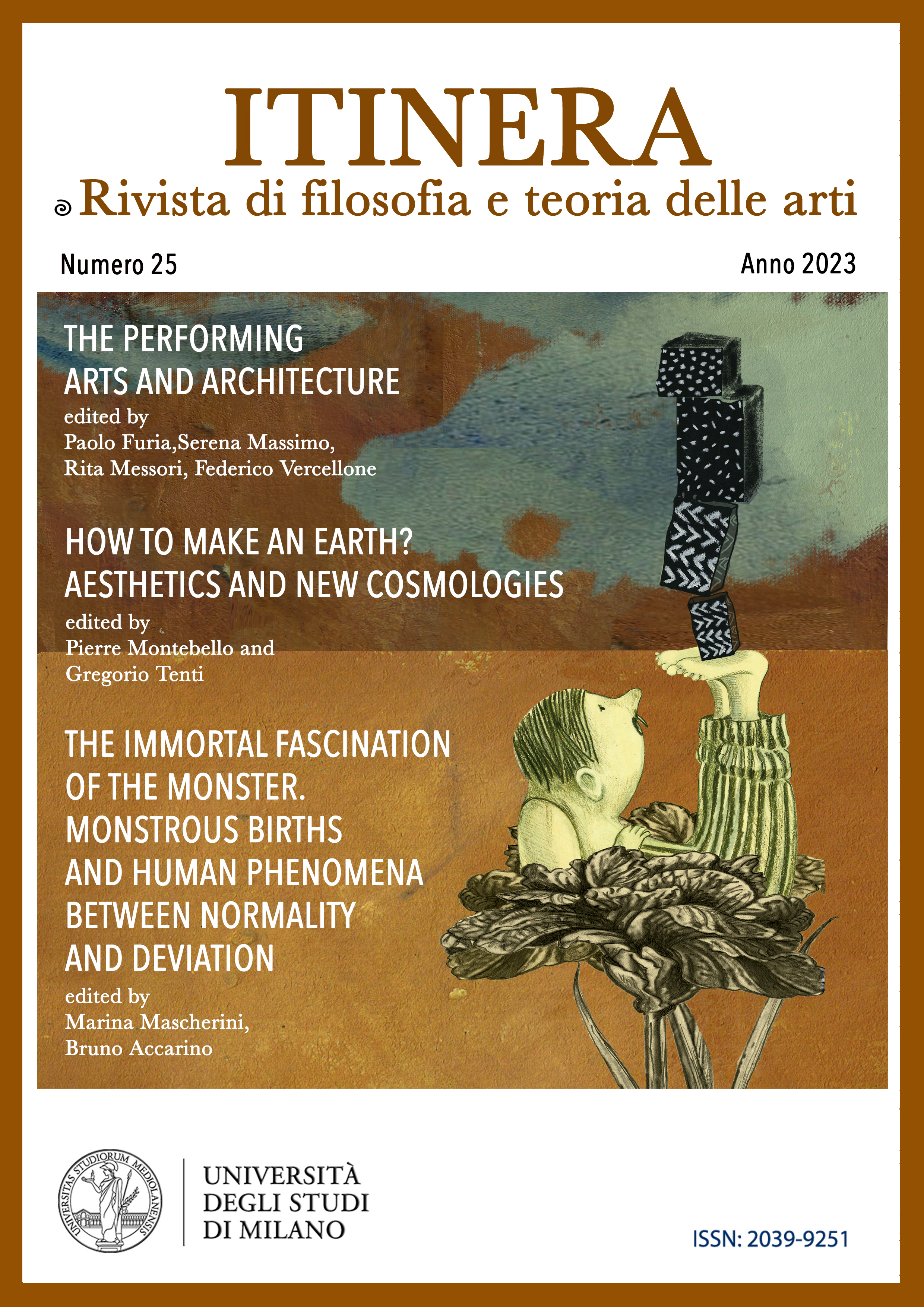Embodying architectures Body extensions and forms in hybrid environments
DOI:
https://doi.org/10.54103/2039-9251/20818Parole chiave:
ost-phenomenology, media transparency, Gestalt psychology, augmented environment, esosomatic and endosomatic transactionsAbstract
This article aims to describe the situated interactions between humans and hybrid architectures composed of physical and digital elements. Using a post-phenomenological perspective and drawing on case studies from everyday life and contemporary new media art, the paper will first discuss the limits and possibilities of this philosophical approach. Specifically, post-phenomenology has limitations in describing the technologies present in hybrid architecture that are becoming increasingly transparent and capable of manipulating the habitat while being embodied in the user and widespread in the environment. Through a genealogical reconstruction of the concept of form in Wolfgang Köhler, Kurt Goldstein, and Maurice Merleau-Ponty, the article will explore the continuity between endosomatic and esosomatic space, providing new tools for the post- phenomenological debate.
Riferimenti bibliografici
Benjamin, W., The arcades project, trans. by H. Eiland & K. Mclaughlin, Harvard University Press, Cambridge & London 1999.
Coccia, E., Filosofia della casa. Lo spazio domestico e la felicità, Einaudi, Torino 2021.
De Preester, H., Technology and the body. The (im)possibilities of re-embodiment, in “Foundations of science”, XVI/2-3, 2011, pp. 119-137.
De Preester, H. & Tsakiris, M., Body-extension versus body-incorporation. Is there a need for a body-model?, in “Phenomenology and the cognitive sciences”, VIII, 2009, pp. 307–319.
Dewey, J., Democracy and education. An introduction to the philosophy of education, Macmillan, New York 1916.
Dewey, J., The Reflex Arc Concept in Psychology, “Psychological Review”, 1896 n. 3, pp. 357-370.
Fedorova, K., Tactics of interfacing. Encoding affect in art and technology, MIT Press, Cambridge & London 2020.
Gallagher, S., Philosophical conceptions of the self. Implications for cognitive science, in “Trends in cognitive sciences”, IV, 2000, pp. 14–21.
Goldstein, K., The organism. A holistic approach to biology derived from pathological data in man (1939), Zone Books, New York 1995.
Gustafson, S., Bierwirth, D. & Baudisch, P., Imaginary interfaces. Spatial interaction with empty hands and without visual feedback, in “Proceedings of the symposium on user interface software and technology”, 2010, pp. 3-12.
Goldstein, K., Human nature in the light of psychopathology, Harvard University Press, Harvard 2013.
Ihde, D., Technics and praxis. A philosophy of technology, D. Reidel Publishing Company, London 1979.
Ihde, D., Technology and the lifeworld. From garden to earth, Indiana University Press, Bloomington 1990.
Ihde, D., Postphenomenology and technoscience. The Peking University lectures, Suny Press, New York 2009.
Ihde, D., Experimental phenomenology. Multistabilities, State University of New York Press, New York 2012.
James, W., Principles of Psychology (1890), Harvard University Press, Harvard 1983.
Köhler, W., Die physischen Gestalten in Ruhe und im stationären Zustand. Eine Naturphilosophische Untersuchung, Braunschweig, Vieweg 1920.
Kwastek, K., Aesthetics of interaction in digital art, MIT Press, Cambridge & London 2013.
Merleau-Ponty, M., The structure of behavior (1942), trans. by A. L. Fisher, Becon Press, Boston 1963.
Malaspina, R. P., Pinotti, A. & Pirandello, S., Emerging, filtering, symbiosing. Experiences in augmented art, in “VCS: Visual Culture Studies”, III-IV, 2022, pp. 101-124.
Parisi, F. & Sartori, S., La temperatura dell’interfaccia. Embodiment, ipnosi e allucinazione, in “Imago. Studi di cinema e media”, XXIII, 2021, pp 23-40.
Rosenberger, R. & Verbeek, P., A field guide to postphenomenology, in R. Rosenberger & P. Verbeek (ed. by) Postphenomenological investigations. Essays on human–technology relations, Lexinton Books, Lanham 2015, pp. 9-42.
Shusterman, R., Somaesthetics and architecture. A critical option, in K. Faschingeder, K. Jormakka, N. Korrek, O. Pfeifer & G. Zimmermann (ed. by) Die Architektur der Weltordnung. Architecture in the age of empire, 11th International Bauhaus-colloquium, Weimar 2009, pp. 282-300.
Stern, N., Interactive art and embodiment. The implicit body as performance, Gylphi Limited, Canterbury 2013.
Toccafondi, F., Il tutto e le parti. La Gestaltpsychologie tra filosofia e ricerca sperimentale (1912-1922), Franco Angeli, Milano 2000.
Verbeek, P., Cyborg intentionality. Rethinking the phenomenology of human–technology relations, in “Phenomenology and cognitive science”, VII, 2008, pp. 387-395.
Whyte, J., Virtual reality and the built environment, Routledge Oxford 2002.
Sitography
Dowloads
Pubblicato
Fascicolo
Sezione
Licenza
Copyright (c) 2023 Samuele Sartori

Questo lavoro è fornito con la licenza Creative Commons Attribuzione - Condividi allo stesso modo 4.0.
Gli autori che pubblicano su questa rivista accettano le seguenti condizioni:
1. Gli autori mantengono i diritti sulla loro opera e cedono alla rivista il diritto di prima pubblicazione dell'opera, contemporaneamente licenziata sotto una Licenza Creative Commons - Attribuzione - Condividi allo stesso modo 4.0 internazionale che permette ad altri di condividere l'opera indicando la paternità intellettuale e la prima pubblicazione su questa rivista.
2. Gli autori possono aderire ad altri accordi di licenza non esclusiva per la distribuzione della versione dell'opera pubblicata (es. depositarla in un archivio istituzionale o pubblicarla in una monografia), a patto di indicare che la prima pubblicazione è avvenuta su questa rivista.
3. Gli autori possono diffondere la loro opera online (es. in repository istituzionali o nel loro sito web) prima e durante il processo di submission, poiché può portare a scambi produttivi e aumentare le citazioni dell'opera pubblicata (Vedi The Effect of Open Access).





